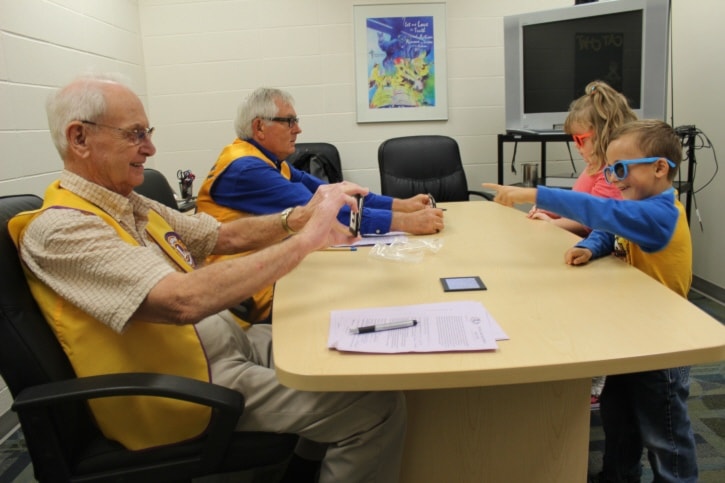Detecting potential vision problems before they fully develop is the aim of a program by Lions club members.
Fred Johannson and other Lions spent last week visiting schools in Sylvan Lake, where they carried out the evaluation. Kindergarten children were asked to point out a large letter ‘E’ on two plaques that were displayed and moved in front of them.
The process, known as stereo screening, seeks to detect potential signs of amblyopia, or lazy eye.
“If that is not found and corrected by the time kids are seven or eight, it becomes permanent,” said Johannson. “Catch it quick, and it’s easy to cure.”
Johannson brought the screening to Sylvan Lake five years ago after reading about Lions clubs in the United States carrying out similar programs.
Lions visit Sylvan Lake schools once a year where they carry out the evaluation on Kindergarten children.
“At that age, the exam at the optometrist is paid for by the government, so nobody has got an excuse not to get their kids’ eyes tested,” he said. Raising awareness is an important part of the evaluations, he added. If he and the other Lions are given even a slight indication of a problem, they won’t hesitate to phone the child’s parents to recommend a visit to the optometrist for a full evaluation.
“We do find some that have been missed,” he said. “That’s the idea: to bring awareness and find the ones that need help.”
Johannson is pleased with the effect the program has had since it began in Sylvan Lake.
About half way through their evaluations this year, the Lions have so far discovered potential problems in four students, whose parents received a phone call recommending they take their child to an optometrist.
That number is a sharp decline from previous years, which Johannson said is a good thing.
“There were probably 20 or 25 in the first year out of about 300 Kindergarten kids in town,” he said. “It’s getting less all the time.”
Johannson said lazy eye affects about three per cent of children, making it important for parents to take their children to an optometrist.
“If we find it, fine. If they take them to the optometrist before school starts, even better,” he said.
While Johannson and the Lions aren’t able to tell parents what is wrong with their children’s eyesight, their simple test provides them with an often-accurate indication of a potential problem.
In one of the program’s first years, a young girl was recommended to visit an optometrist after struggling during the evaluation. She was eventually found by an optometrist to be legally blind.
Another child was found to be blind in one eye. That child’s mother told Johansson that the test changed her child’s life.
“It makes you feel pretty good,” said Johannson.
When carrying out the evaluation, hesitation shown by a child in pointing out the target letter is a sign of a potential problem, said Johannson.
The evaluation usually lasts under a minute, with longer time spent on children who seem to be experiencing difficulty.
Most parents are supportive of the program, and sign the form necessary for the Lions to go ahead with the testing, said Johannson. As are most teachers, whose classes remains largely uninterrupted while the evaluations are carried out.
“We went through just about 30 kids this morning in half an hour,” said Johannson.
He’s recently been bringing younger Lions members to evaluations with him so they can carry on the important program when he is unable to do so. Catching problems early can change the course of a child’s life, he said.
“If there are any doubts, you can’t take any chances at all.”
